

Environment: Lost in Japan: How to defend against tsunamis. Allianz Knowledge: It wasn’t the earthquake but the following tsunami that caused most devastation in Japan.
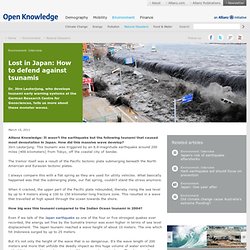
How did this massive wave develop? Jörn Lauterjung: This tsunami was triggered by an 8.9-magnitude earthquake around 250 miles (400 kilometers) from Tokyo, off the coastal city of Sendai. The tremor itself was a result of the Pacific tectonic plate submerging beneath the North American and Eurasian tectonic plates. I always compare this with a flat spring as they are used for utility vehicles. Japan earthquake and tsunami: Aftershocks go on as 10k missing in Minami Sanrik. By Jo Macfarlane Updated: 11:36 GMT, 14 March 2011 42 survivors have been pulled out of the rubbleOfficial death toll hits 1,597, but many hundreds believed to be buried under rubble or washed away by wavesToll will soar after around 2,000 bodies were found on the shores of Miyagi prefectureSecond explosion at nuclear power plantNumber of people contaminated with radiation could reach 160Region hit by hundreds of aftershocks, some up to 6.8-magnitudeRescue operation begins but some areas still cut off by road damage and flood waters70,000 people evacuated to shelters in Sendai Forty-two survivors have been pulled from the rubble in the flattened town of Minami Sanrik, where up to 10,000 people are feared to have perished.
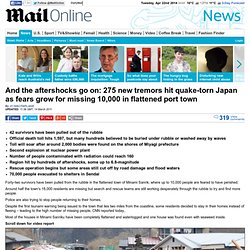
Around half the town's 18,000 residents are missing but search and rescue teams are still working desperately through the rubble to try and find more people. Police are also trying to stop people returning to their homes. Scroll down for video report. Workshops, Inspiration, and Community. Weather Wiz Kids weather information for kids. Earthquakes(Earthquakes are not associated with weather, but instead are natural disasters.)

What is an earthquake? Earthquakes are the shaking, rolling or sudden shock of the earth’s surface. They are the Earth's natural means of releasing stress. More than a million earthquakes rattle the world each year. The West Coast is most at risk of having an earthquake, but earthquakes can happen in the Midwest and along the East Coast. Click Here to learn more about earthquakes from USGS. What causes an earthquake? Click Here to see an animation of an earthquake. What are plate tectonics? What is a seismograph? Causes of Tsunamis. “Black Tsunami”: Interview with James Whitlow Delano about Documenting the Devastation of the 2011 Tohoku Tsunami. Eric’s Note: I am honored to share this interview with James Whitlow Delano, a talented photojournalist whose work has been awarded intentionally, including the Alfred Eisenstadt Award (from Columbia University and Life Magazine), Leica’s Oskar Barnack, Picture of the Year International, NPPA Best of Photojournalism, PDN and others for work from China, Japan, Afghanistan and Burma (Myanmar).

His most recent iPad book Black Tsunami (FotoEvidence) documenting the Japan tsunami and nuclear crisis took a 2012 PX3 Award. James is now trying to get his “Black Tsunami” book published as a hardcover book. Check out the Kickstarter page and support this noble cause, and also check out my interview with him below. 1. Great to have you James. An ocean going ship sits where it came to rest in the debris of the great 25m high (82 ft.) tsunami that hit Kesennuma, Miyagi Prefecture following the massive earthquake that struck under the sea off of Japan. 2. 3. I have lived in Japan for 20 years. 4. 5. The Pacific Tsunami Museum. Before a tsunami. How to prepare for a tsunami Check your house and land for any potential dangers related to flooding.
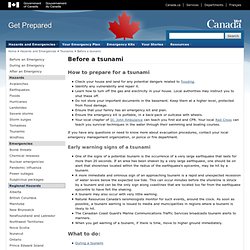
Identify any vulnerability and repair it. Learn how to turn off the gas and electricity in your house. Local authorities may instruct you to shut these off. Do not store your important documents in the basement. If you have any questions or need to know more about evacuation procedures, contact your local emergency management organization, or police or fire department. 2004 Indian Ocean earthquake and tsunami.
The 2004 Indian Ocean earthquake was an undersea megathrust earthquake that occurred at 00:58:53 UTC on Sunday, 26 December 2004, with an epicentre off the west coast of Sumatra, Indonesia.
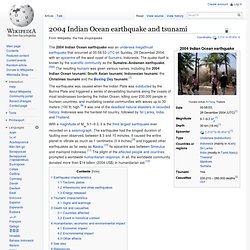
The quake itself is known by the scientific community as the Sumatra–Andaman earthquake.[5][6] The resulting tsunami was given various names, including the 2004 Indian Ocean tsunami, South Asian tsunami, Indonesian tsunami, the Christmas tsunami and the Boxing Day tsunami.[7] The earthquake was caused when the Indian Plate was subducted by the Burma Plate and triggered a series of devastating tsunamis along the coasts of most landmasses bordering the Indian Ocean, killing over 230,000 people in fourteen countries, and inundating coastal communities with waves up to 30 meters (100 ft) high.[8] It was one of the deadliest natural disasters in recorded history. Indonesia was the hardest-hit country, followed by Sri Lanka, India, and Thailand. Earthquake characteristics.
Tsunami. Advertisement.

EnchantedLearning.com is a user-supported site. As a bonus, site members have access to a banner-ad-free version of the site, with print-friendly pages.Click here to learn more. (Already a member? List of historic tsunamis. This article lists notable historical tsunamis, which are sorted by the date and location that the tsunami occurred, the earthquake that generated it, or both.

Because of seismic and volcanic activity tectonic plate boundaries along the Pacific Ring of Fire, tsunamis occur most frequently in the Pacific Ocean, but are worldwide natural phenomena. They are possible wherever large bodies of water are found, including inland lakes, where they can be caused by landslides and glacier calving. Very small tsunamis, non-destructive and undetectable without specialized equipment, occur frequently as a result of minor earthquakes and other events. As early as 426 BC, the Greek historian Thucydides inquired in his book History of the Peloponnesian War (3.89.1–6) about the causes of tsunamis. He argued rightly that it could only be explained as a consequence of ocean earthquakes, and could see no other possible causes for the phenomenon.[1] Rare Video: Japan Tsunami. 2011 Japan Earthquake and Tsunami Relief « Direct Relief. On March 11, 2011, the magnitude-9.0 Tohoku Earthquake and subsequent tsunami and nuclear disaster struck northern Japan, killing over 16,000 people and leaving an estimated 3,000 missing.
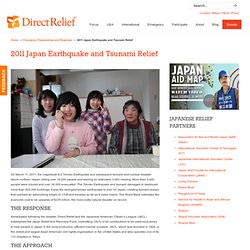
More than 5,400 people were injured and over 34,000 evacuated. The Tohoku Earthquake and tsunami damaged or destroyed more than 900,000 buildings. It was the strongest known earthquake to ever hit Japan, creating tsunami waves that reached an astonishing height of 133ft and traveled as far as 6 miles inland. The World Bank estimates the economic cost to be upwards of $235 billion, the most costly natural disaster on record. Two years later, Japan seethes at tsunami recovery. An elderly man sits as he and with his wife (not pictured) visit a cemetery to pay respects to their son who was killed in the March 2011 tsunami, in Minamisoma in Fukushima prefecture on March 11, 2013.

Getty Images. Funds to help Japan tsunami victims find work spent in unaffected areas. More than ¥100bn (£650m) of a special budget set up to help victims of Japan's March 2011 triple disaster find work has been spent on projects that have no connection to the tragedy, including cheese and wine promotions. Tens of billions of yen earmarked for employment schemes was spent on a range of initiatives located far from the tsunami-hit region, such as counting sea turtles, publishing a restaurant guide and publicising a mascot for a local prefecture, a Japanese newspaper said.
Tsunami Facts for Kids - Interesting Information about Tsunamis. Survive a Tsunami (for Kids) Edited by Flickety, OhioMike, Socha.michael.123, Lillian May and 92 others When an earthquake occurs or an volcano erupts under water, the waves travel like ripples on a pond after you throw a rock. The waves can be very tall, move very quickly and cause great damage when they strike land. This is called a tsunami and anybody in the path of it is in great danger. Survive a Tsunami.
Steps Part 1 of 4: Preparing in Advance 1Learn about the potential for danger in advance. It is important to consider in advance whether or not you live somewhere that could potentially face a tsunami. It is likely that you are at some risk if: Your home, school, or workplace is in a coastal region, near the sea.The elevation of your home, school or workplace is at sea level or fairly low and on flat or only slightly undulating land.
If you don't know the elevation level of your home, school or workplace, find out.